How to Expand Your Organic Growth on Facebook and Twitter for Free
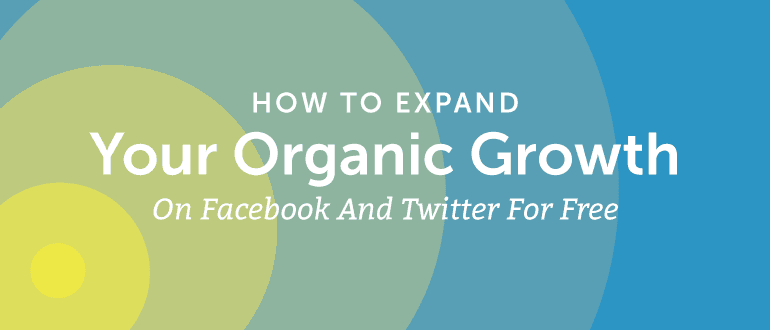 When it comes to social media, every brand wants in on the action. It’s no secret that social media marketing works only if a brand actually has fans or followers. Amassing a respectable audience on Facebook, Twitter, Google+ (is that still a thing?), Linkedin, Instagram or any of the other platform du jour is tough.
Many brands and small businesses want their social media presence to be organic, meaning no money invested. Having a good, or great, social media presence can help any business grow like wildflowers. But, this will only happen after it develops a large following and then works consistently to engage, educate, and cultivate this audience. Brands want the growth and audience, but aren’t willing to pay for it.
Seems like a catch 22.
Can a brand simply grow their social audience organically? Is that even possible in today’s pay-to-play landscape? Here are some metrics.
When it comes to social media, every brand wants in on the action. It’s no secret that social media marketing works only if a brand actually has fans or followers. Amassing a respectable audience on Facebook, Twitter, Google+ (is that still a thing?), Linkedin, Instagram or any of the other platform du jour is tough.
Many brands and small businesses want their social media presence to be organic, meaning no money invested. Having a good, or great, social media presence can help any business grow like wildflowers. But, this will only happen after it develops a large following and then works consistently to engage, educate, and cultivate this audience. Brands want the growth and audience, but aren’t willing to pay for it.
Seems like a catch 22.
Can a brand simply grow their social audience organically? Is that even possible in today’s pay-to-play landscape? Here are some metrics.
Here’s a 10 step recipe for growing an organic audience on Facebook and Twitter
Click To TweetHow to Get 129% Organic Growth on Twitter and 239% on Facebook With 100% Organic Tactics
No, this isn’t a fairytale in the land of make believe that is social media. It’s actually the metrics after recently (within past two months) concluding a relationship with one of my first social media clients ever. The client, let’s call them DFX (name changed), works in the financial sector so the competition is high, with tight regulationsHere’s a 10 step recipe for growing an organic audience on Facebook and Twitter
Click To TweetKnow the Fundamentals to Grow a Social Media Audience the Right Way
Organic growth is based on three fundamentals:- Consistency
- Knowledge
- Being real (authenticity)
1. Perform a Social Media Audit
After vowing to embrace the fundamentals, an important step in growth is to first assess what’s been done. Conduct a social media audit of your existing process, strategy, and flow.- Calendar of content: Yes, this is number one on an audit. Without a content calendar that stresses consistency, valuable brand focused and industry relevant content the entire social media and digital effort will be sloppy.
- Audience mapping: Identify leaders, influencers, and key figures in the space. Content should be shaped and guided by the conversations of these industry figures. Focus the brands engagement efforts and optimize content to this audience. Additionally, the content style of others in your space should offer insight into what resonates with the readers.
- Timing: Content should be posted at optimal times based on the highest concentration of readers. The easiest method to start an audit about timing is to use Facebook Insights which will highlight the trends.
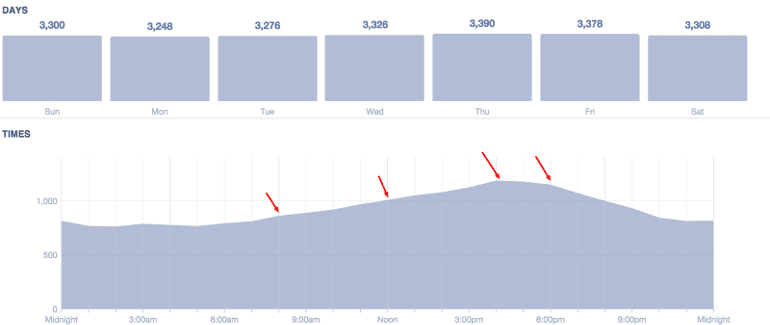
- Frequency of content sharing and use of hashtags: Posting content at the right time is one aspect of timing. The frequency of sharing relevant content to these audiences is also important. It does take a bit of trial and error. Using hashtags can also boost reach of your content. How often is content posted? When are hashtags, if at all, used? How many hashtags?
- Image Quality: Unfortunately, this is a problem that many brands confront (more about this later). This should be as important as the rest of your content. Is the image shareable? Will it look right when shared across digital channels? Has it been tagged on the CMS backend?
- Word Choice: Brands often auto share their content without being mindful of what will actually engage their readers.
- Engagement vs Automation: Every brand schedules content. Automation helps, but it can’t replace human interaction and engagement. How often is content scheduled and pushed out and how often does the brand engage with its users, those who share its content?
2. Build Out Your Content Calendar
In order for a brand to truly grow its organic audience and, by default, its reach, it needs to be strategic about its posting of content. Creating a proper schedule that drills down to the topics, the word choice, timing, style on each social platform, what call-to-action (only one per post please), awareness of important calendar dates within the industry or relevant holidays, will focus all marketing and communication efforts. Synchronizing these efforts is the most important. Why? Knowing these critical pieces of information eases the entire flow of content to be a deliberate process. A complete content calendar spans over a few months and includes all of the postings and themes that will be focused on during this time frame.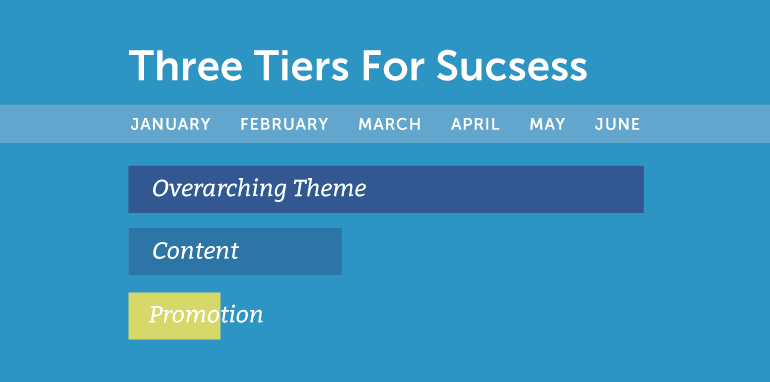 The calendar should be amenable to change, as trends shift and brands need to modify accordingly. A calendar should not only include campaign themes, but also any events, sponsorships or webinars. CoSchedule offers a very detailed content calendar for free.
The calendar should be amenable to change, as trends shift and brands need to modify accordingly. A calendar should not only include campaign themes, but also any events, sponsorships or webinars. CoSchedule offers a very detailed content calendar for free.
A content calendar should not only include campaign themes, but also any events, sponsorships or webinars.
Click To Tweet3. Try Reverse-Engineering Hashtags
For several clients, I’ve found that the best way to identify which content should be posted on what days, was to reverse engineer the calendar based on hashtags. How can hashtags define an entire content calendar? Hashtags simply let a brand associate their content, tweets, or posts with a larger conversation on a global scale? Yes, global. So a brand can easily grow their page by using a hashtag? Yes! It's like adding keywords to your message to make it globally searchable. Which hashtags are right for your brand? Use Hashtagify to identify the relevance of a specific hashtag and other relevant ones associated to the main one.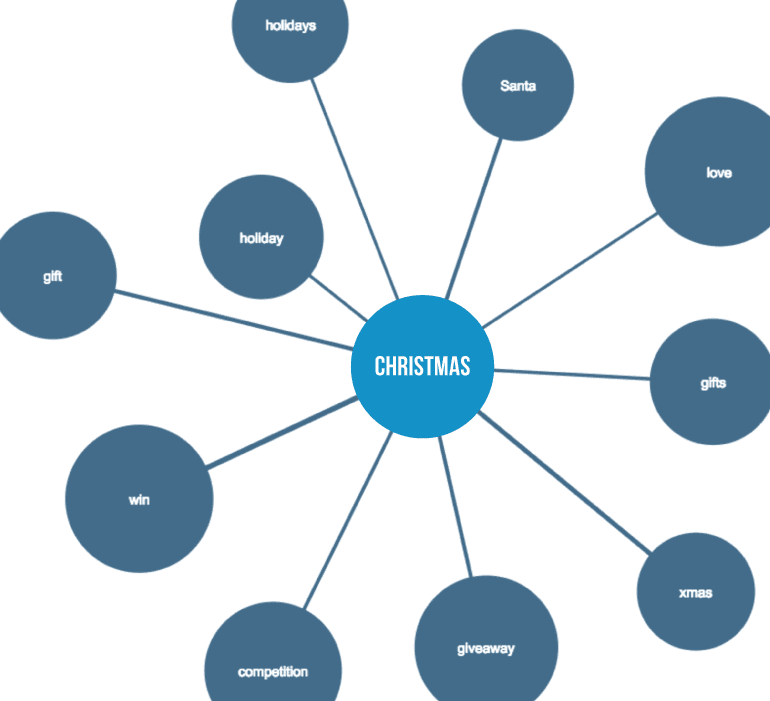 Once identified, brands can then leverage this information for competitive research, content curation, and influencer mapping. Every industry has hashtags. Remember, they’re like keywords.
Recommended Reading: How to Use Hashtags Effectively Without Being Annoying
Once identified, brands can then leverage this information for competitive research, content curation, and influencer mapping. Every industry has hashtags. Remember, they’re like keywords.
Recommended Reading: How to Use Hashtags Effectively Without Being Annoying
4. Search For Relevant Twitter Chats
Once a brand has mapped the right hashtags, go one step further by searching for relevant Twitter chats. These weekly or bi-weekly online conversations on Twitter are a secret way to grow an organic audience. Use the Twubs to search the extensive calendar for relevant conversations: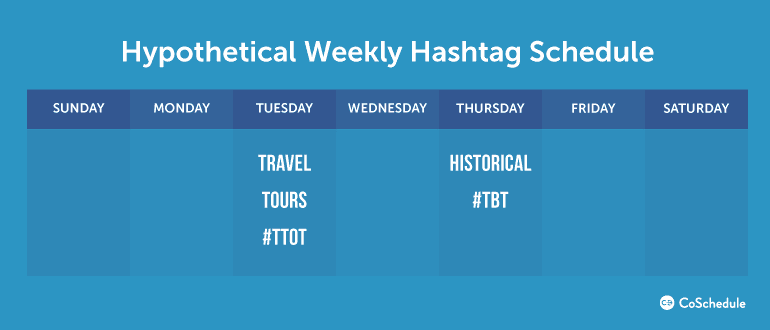 Bam! Your brand has just created its content bible by reverse engineering a content schedule framed around relevant conversations, industry topics, and optimal engagement.Tuesdays are now set in terms of branded content. Continuing with the travel theme, any destination is rich with history. Why not use the popular #TBT (throw back Thursday) to highlight the changing landscape of a location over time?! With two days of content framed around hashtags, the rest of the week should be much easier to plug in.
Bam! Your brand has just created its content bible by reverse engineering a content schedule framed around relevant conversations, industry topics, and optimal engagement.Tuesdays are now set in terms of branded content. Continuing with the travel theme, any destination is rich with history. Why not use the popular #TBT (throw back Thursday) to highlight the changing landscape of a location over time?! With two days of content framed around hashtags, the rest of the week should be much easier to plug in.
5. Know that Timing is Everything
Once you know what to post, now it’s time to determine when to post it. Organic growth starts with knowing when your brand’s audience is online. Timing for each platform does vary. We even wrote a post the best times to post on each platform, which digs deep into the topic of timing content for optimal viewing. For a day-to-day analysis, CoSchedule conducted extensive research on optimizing the timing of content for best engagement. For DFX, Sundays, an otherwise slow time in the trading/ financial sector, was a chance for the brand to offer valuable information that is relevant to the upcoming week. It was also a time to highlight some key figures and personalities in the industry.
For DFX, Sundays, an otherwise slow time in the trading/ financial sector, was a chance for the brand to offer valuable information that is relevant to the upcoming week. It was also a time to highlight some key figures and personalities in the industry.
Get more social media engagement by offering valuable content during off-peak times.
Click To Tweet6. Get Your Frequency Dialed In
Once your brand knows when to post the content for optimal viewing, now the question is how often should a brand post its content. Guy Kawasaki is famous for his unique social media content strategy, sharing the exact content four times a day, eight hours apart. Why? Simply stated, why get 600 views when you can get 2400 by sharing it multiple times? Besides, if your audience sees your content more than once then they’re probably sitting in front of their computer for way too long.
When it comes to social media success, timing is everything.
Click To Tweet7. Understand Audience Mapping
Organic growth on social media can be as simple as mapping your target audiences. Start by telling BuzzSumo the category of content that best suits your brand, BuzzSumo will produce a list of the most influential people in the space, it will also share a list of content pieces that have performed extremely well. This makes your job a whole lot easier. If you have a BuzzSumo subscription, start by logging in. Then, select Influencers: Next, enter a keyword related to your industry, and click Search:
Next, enter a keyword related to your industry, and click Search:
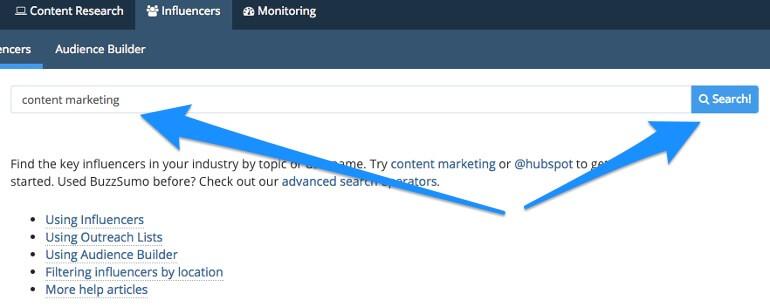 Now, start following these people:
Now, start following these people:
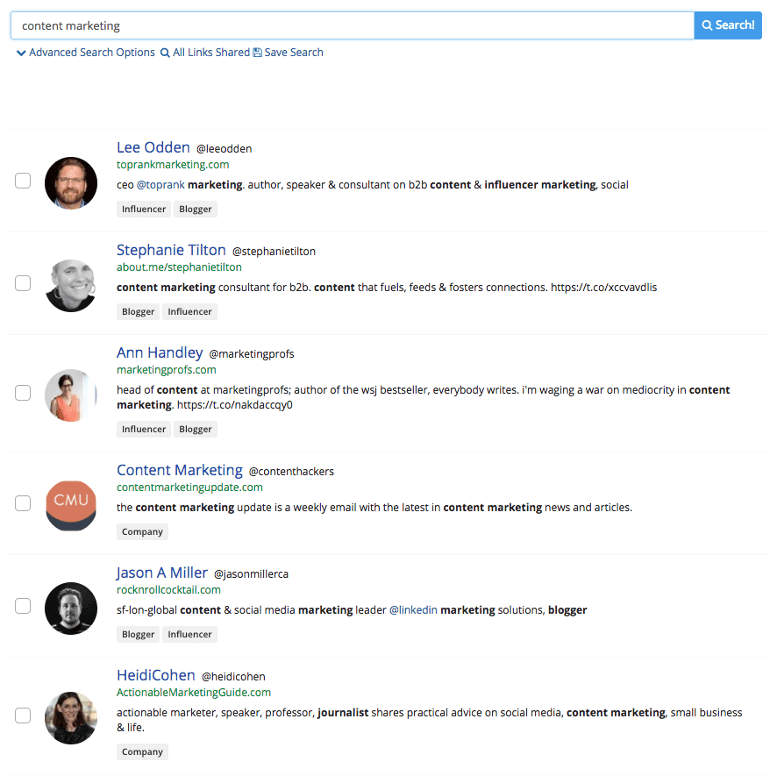 For DFX, we mapped over 3,000 influencers and brands that we’d like to work with and engage in meaningful conversations (more on that later). 3,000. It took a long time to map them but the ROI was impressive.
Once a respectable list is generated, sort each member of the audience, especially competition, by their social following.
Next, is to follow these brands on Twitter and Facebook who share content that resonates with your brand profile. What will most likely happen is that top ones will rise to the top. Use their metrics as a benchmark.
At DFX, we followed them across social channels, like Facebook Pages to watch, signed up to their newsletters, and subscribed to their RSS feeds.
For DFX, we mapped over 3,000 influencers and brands that we’d like to work with and engage in meaningful conversations (more on that later). 3,000. It took a long time to map them but the ROI was impressive.
Once a respectable list is generated, sort each member of the audience, especially competition, by their social following.
Next, is to follow these brands on Twitter and Facebook who share content that resonates with your brand profile. What will most likely happen is that top ones will rise to the top. Use their metrics as a benchmark.
At DFX, we followed them across social channels, like Facebook Pages to watch, signed up to their newsletters, and subscribed to their RSS feeds.
Watch your competition's Facebook pages, get their newsletters, and subscribe to their RSS feeds.
Click To Tweet8. Automate Content
Unless your brand is Superman, there’s never enough time in the day to post content around the clock. Automation helps with making social media growth more efficient and effective. It’s not intended to be the only form of social media. Automation is half of the solution. Care to guess the other? Yup, engagement. See number 6. Once a brand understands that automation and real conversations are both important, that real organic growth can take place. Looking for automation tools? Here’s a list of 9 social media management tools that cross all platforms.9. Engage Your Audience
Social media is a behavioral shift. It’s not a broadcast platform. Engaging an audience and a community is one of the toughest aspects of social media marketing. Finding the right balance between branded content and audience generated content is not easy. For every brand it will vary. For some it can be funny pictures, memes, videos, gif’s, or a white paper. Once a brand does have a following it means engaging, supporting and sharing their content, responding to their comments, and helping them if necessary.Social media is a behavioral shift. It's not a broadcast platform.
Click To Tweet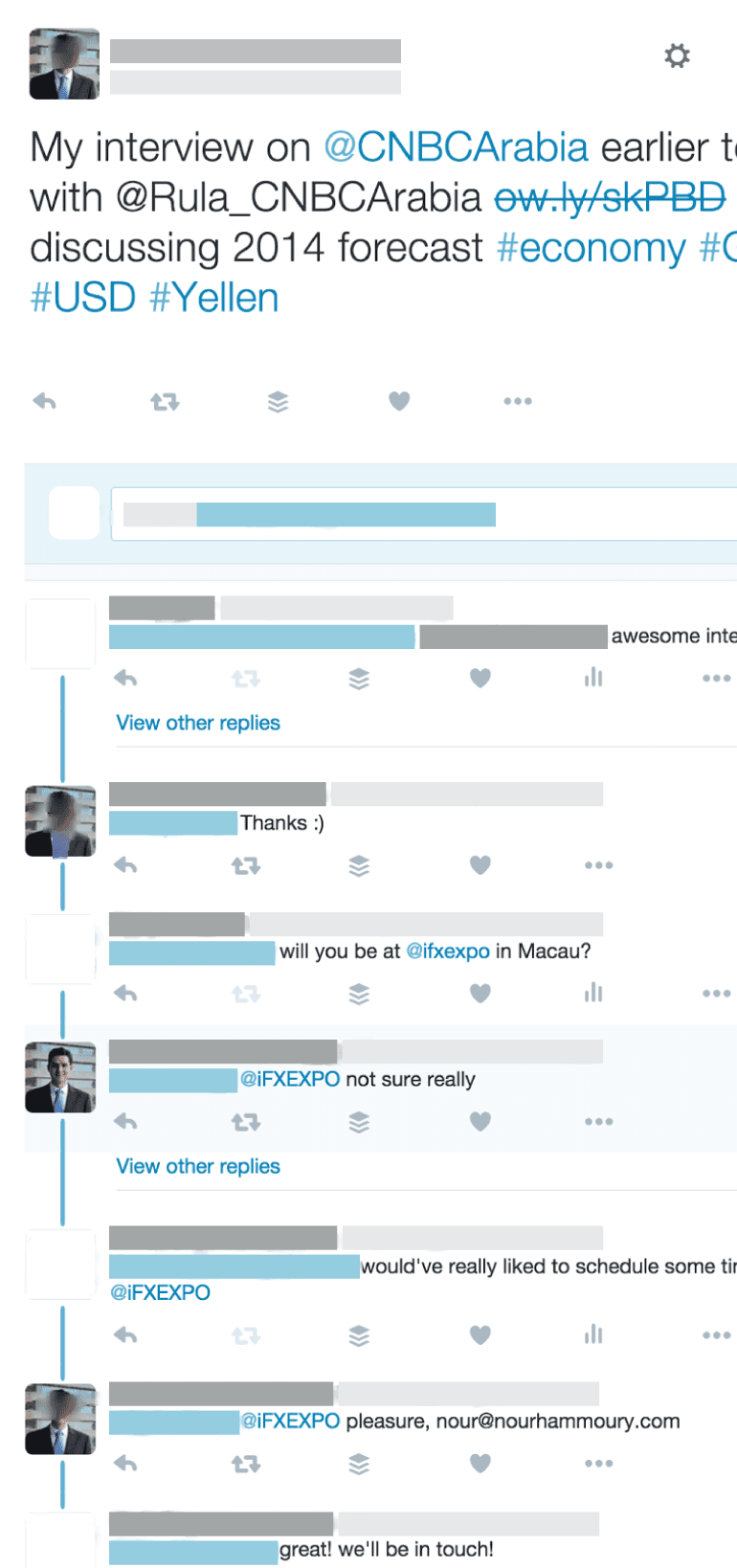 Look at that! The brand engaged in a meaningful way and landed a meeting (face-to face) and took the conversation offline.
Look at that! The brand engaged in a meaningful way and landed a meeting (face-to face) and took the conversation offline.
10. Take it Offline
That’s right, one of the best ways of growing an organic social audience is to find ways to take it offline. That could be a phone call, a webinar, a meeting at a conference (via the hashtag), or webinar. Bridge the online offline gap and a put a face to the brand. Make it happen. Tweeting and posting can be done all day, but until a real connection is made, the deal won’t be sealed.one of the best ways of growing an organic social audience is to find ways to take it offline.
Click To Tweet11. Aesthetics is Everything
Visuals can make the entire difference in organic growth. It can boost brand visibility while supporting all digital efforts. With such a cluttered social space, high quality, attractive visuals make a brand memorable. Visual content is easier for humans to process and is an easy way to generate more views, click throughs and followers. Rather than just use the same text, or the default image that comes up when putting a link to Facebook or Google Plus, why not be creative?Social media marketing is a marathon.
Click To Tweet

